What Is the Frame in Which Cave Art Was Made
Detect how it is possible to date stone and cavern paintings, using science.
Introduction to dating cave paintings
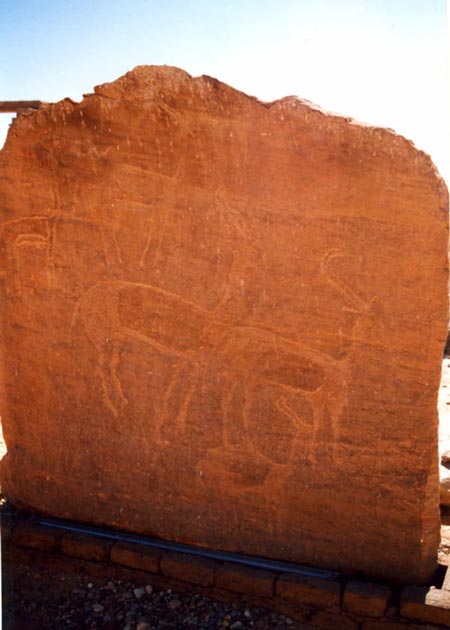
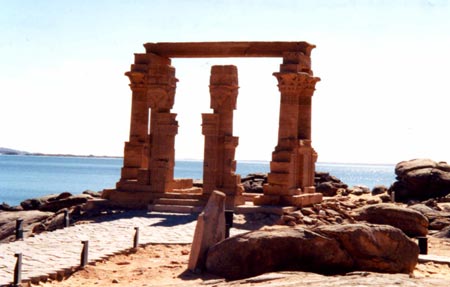
Effigy 1: Predynastic Egyptian petroglyphs near the Kiosk of Qertassi (5 – 3,000BCE) New Kalabsha, Southern Egypt. Pat O'Brien
These animal carvings now in New Kalabsha, Southern Egypt are older than the ruin, the Kiosk of Qertassi that they stand up beside (Figure 1).
- How practice we analyse to find out if they are as old equally we call up they are?
The problem is that they are just marks cutting or incised into the stone and our ability to age them is not equally good as with organic materials. Defining the subject field and age of rock paintings can mean archaeologists are able to make up one's mind more virtually the life of prehistoric peoples and acquire a amend understanding of our origins. However, dating rock art has been a struggle for archaeologists ever since the first discoveries of it in the tardily 19th century.
It is possible to determine a number of things based on where the art is found and when it was establish, but not everything can be learnt from that.
Dating ancient textile relies on the use of two approaches – directly or absolute and indirect or relative dating or chronology.
For example, consider relative dating. If something is establish with some other object that the archaeologist already knows the age of and the area has not been disturbed since they were placed together, it is safe to say they both come from the same fourth dimension. More importantly, if it is establish below the object archaeologists know it must be older. That is chosen context or stratigraphic relationship and it's how archaeologists date objects as they dig. But it does not produce precise dates. If archaeologists can appointment something precisely that is absolute dating. The trouble is information technology requires highly scientific methods.
There is a difficulty with something painted, particularly if the paints all seem to take the same composition. Here, archaeologists have to use the materials themselves and attempt to appointment it using some property or component within the material. The most mutual example of this form of accented chronology, which we can use with rock paintings, is radiocarbon dating. If nosotros tin can use that technique it tin give a reasonably authentic age upward to approximately 50,000 BCE (Before Common Era like to BC, Earlier Christ).
Radiocarbon dating
Radiocarbon dating (also called carbon dating) but works with organic things; materials that came from living things.
- Where does the radioactive carbon come from?
- How can it tell us how quondam an organic textile is?
It relies upon the fact that plants take in carbon dioxide during photosynthesis and use it to make its chemicals. Animals consume these plants and the carbon is taken up into their chemicals.
The carbon element is composed of two unlike atoms called isotopes (meaning they have the same number of protons but there are differing numbers of neutrons in each different type of atom). When we add together the number of protons, also known as the diminutive number, to the number of neutrons, the full is the atomic mass number. The about common carbon atom has half-dozen protons and six neutrons, so the atomic number for this carbon isotope is vi and the atomic mass number is 12. This tin can exist written as:

Carbon typically has 6 neutrons making the isotope carbon 12 (C12), but some carbon atoms accept 7 neutrons making carbon 13 (C13) and some carbon atoms accept 8 neutrons making carbon 14 (C14). The carbon 14 isotope is radioactive. The various isotopes are found in organic materials in the proportions shown in Figure two.
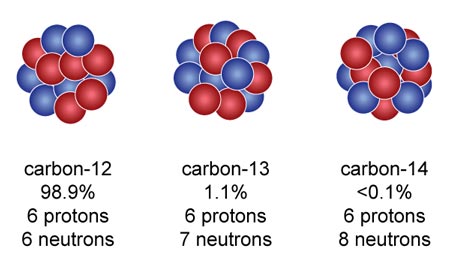
Figure 2: Carbon istopes (12, thirteen, 14). Peter Bull
All the fourth dimension an organism is alive it takes upwardly all forms of the carbon isotopes to make its chemicals just on death it stops taking in any carbon.
Carbon dating works because the corporeality of carbon xiv in the atmosphere has non changed in thousands of years. Carbon 14 is formed as cosmic rays hitting atoms in the upper atmosphere. Living things, while they are nevertheless alive, absorb the isotopes of carbon. This means all living things have radioactive carbon 14 in them (Figure iii).
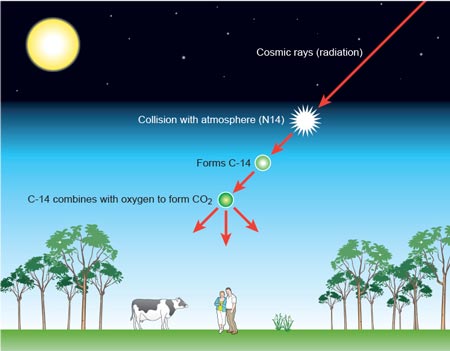
Figure 3: Carbon xiv entering the atmosphere. Prototype courtesy of Peter Bull.
After a living thing dies, the amount of carbon 14 in the material decreases with time it decays with a half-life of about 5700 years into nitrogen (Effigy 4).

Figure 4:Half-life graph of carbon 14.
Carbon dating involves the measuring of the amount of the radioactive carbon isotope C14 absorbed by living things into the organic matter. By comparing how much carbon 14 in that location is in the dead organism with the amount in a living one, the age of the dead organism can be estimated.
Why can't we employ radiocarbon dating with some pigments?
The difficulties with pigments
The difficulty with carbon dating pigments is that they are oftentimes made from rocks, and do not contain organic matter. Where there are engravings or paintings that lack any organic pigments or binders at that place is no basis for the build up of natural carbon 14.
- What about limestone?
- Isn't that a sedimentary rock made upward of once living cells and and then contain carbon?
In some paints where suitable materials such every bit limestone, chalk or charcoal pigments do be, we can use carbon dating. The sample size tin can just exist very pocket-sized otherwise the painting will be damaged or the level of contamination by the tools we employ to accept the sample volition be high and could produce less authentic results.
Carbon dating also relies upon sure assumptions. The beginning is that carbon 14 has always been produced and had the same concentration in the atmosphere. This assumption is more important the older the carbon sample is. After 10,000 years in that location are no absolute calibration points such as tree rings. The second assumption is that radioactive disuse rates stay the aforementioned and have always been what we measure them now to be. Because of the one-half-life of carbon 14 the radiocarbon dating method is simply useful for limestone's or chalks less than 30 meg years old.
- Can radiocarbon dating be more than accurate?
Up to 2009 just small-scale amounts of organic matter could be dated directly using carbon isotope decay. And so a new, highly sensitive dating method, called accelerator mass spectrometry (AMS) was developed. It'south an expensive merely effective method, since it only requires 0.05 milligrams of carbon (the weight of 50 specks of grit). That's much less than the 1 to x grams of carbon needed with normal carbon dating.
In general terms, in AMS scientists create negative ions by bombarding atoms with fast moving particles which are accelerated using a particle accelerator. Then, using a mass spectrometer, they count all the carbon xiv atoms and from that piece of work out the age.
To cheque its accuracy, inquiry was carried out which analysed pictographs containing organic pigments from a number of countries over 15 years. This validation showed the method to be very successful allowing rock painting to bring together bones, pottery and other artefacts every bit materials that could be dated.
- Is radiocarbon dating the just absolute method for dating rock art?
Uranium-Serial Disequilibrium
In 2010 a new development allowed the El Costillo paintings in Spain to be dated more accurately, pushing the advent of cave painting back 10,000 years.
This new method involved the measurement of the decay of inorganic materials. It measured the decay of uranium isotopes in the sparse calcite flowstone growths that form on the surfaces of the paintings and engravings. Flowstones are created as water dissolves calcium compounds that are after deposited when the h2o collects on a prominent point forming a special type of stalagmite (Figure 5).
The research team was conducted past scientists from the University of Bristol. The team included Dr Paul Pettitt from the University of Sheffield's Department of Archeology a renowned expert in cave art.
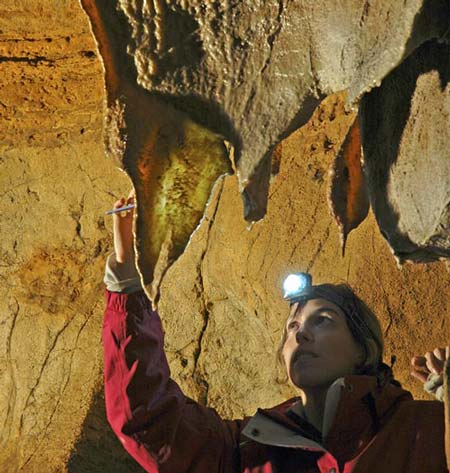
Effigy 5: Scientist removing a sample from the surface of a flowstone in El Costillo. Tito Bustillo
Flowstones are formed where water flows down the walls or along the floors of a cave. They are typically formations in limestone "solution caves", where they are the nearly common secondary eolith or speleothem. Speleothem'due south can form in whatsoever type of cave where water enters, including igneous lava tubes. The water dissolves minerals, among which can be uranium isotopes.
The team of scientists from the Great britain, Spain and Portugal dated the formation of tiny stalactites on top of the paintings. This gave a minimum age for the art. Where larger stalagmites had been painted, maximum ages were also obtained. This technique is used a lot in Earth Sciences, and was used on 50 paintings in 11 caves in Northern Kingdom of spain, including the UNESCO World Heritage sites of Altamira, El Castillo and Tito Bustillo. It is sensitive and avoids the issues in dating by radiocarbon.
Electron Spin Resonance (ESR)
Another method for dating calcite rocks is electron spin resonance (ESR) also known as electron paramagnetic resonance (EPR). This is based on the measurement of electron-pigsty centres accumulated with time in the crystal lattice of CaCOiii exposed to natural radiations.
An electron hole is the absence of an electron from an otherwise full valence band. Imagine a row of people sitting in the final row in a theatre. The person in the heart gets up to leave and does this by jumping over the back of their seat into the next row and is then free to motility abroad. The person is similar to a free electron escaping the atom and the empty seat is the hole. To fifty-fifty up the seating the people move forth to fill the seat eventually leaving the hole at the border and so everyone has moved along. If the pigsty is assumed to exist positively charged then the negatively charged electrons will have moved along leaving a positive hole on the edge. This open electron shell or unpaired electron is known as a costless radical and is highly reactive. Sadly ESR is not as reliable as scientists would hope so it is used with caution.
Many of these instrumental techniques are new to archaeological dating. In the past, in order to date cave and stone art, archaeologists looked for other methods such every bit those used by art historians. These are indirect tools ofttimes open to a lot of discussion as to their accuracy. They include the post-obit:
Stratification techniques: The position of the object or painting relative to some other dateable objects. For example, in the cave of Le Tuc, France, 2 stalagmites had to be removed earlier the cave art could be reached and these were dated assuasive an interpretation of the age of the painting to be made.
Patination: The advent of a movie or scratches on the surface due to fourth dimension. This has been used by some scholars to requite a sense of the relative historic period of different petroglyphs. Sweinfurth, in 1912, was i of the first to utilise patination to engagement some engravings. Then in 1938 Winkler formed a chronology of archaeological occupation of the Eastern Desert. He based his arroyo on the strength of patination over the rock art scenes. He used a relative rating scheme to aid him make estimations of age. A 0 rating was for a loftier patination and older, while a ten was indication of a shallow patination and younger. Accepting Winkler's chronological scheme was innovative it has been attacked on many occasions because of the effect of the differentiation of light due to shade or conditions due to air current direction on conditions over the surface of a stone painting, and how that might cause non-uniform patination.
Superimposition: Where 1 cartoon has been etched on summit of some other. This could institute that one image is more recent than another, but doesn't give whatever data about the time gap between the drawings of the two images. Using a combination of superimposition and patination information technology might be possible to contend that the ii are some distance apart in terms of historic period. However, at that place is always the possibility the artist superimposed 1 prototype over another deliberately, and that they are of identical or like age.
Weathering: Where the bear on of chemical and physical processes on an image after information technology has been created is determined. Lorblanchet in 1992 tried using radiocarbon dating to date some Australian rock fine art but found it inaccurate and then suggested that differential weathering could provide an indication of the relative ages of dissimilar rock art images. Unfortunately, weathering does not necessarily occur at a consequent rate across all rock art surfaces in a given area, and is not always a reliable fashion of determining relative ages. A more scientific approach to weathering is micro-erosion analysis, pioneered in Australia past Bednarik in 2002. One method is to examine the surface of a rock using a microscope and to measure out the charge per unit of weathering of the rock in a given expanse. This is done by sampling a number of rock surfaces set upward to undergo simulated weathering and comparing the simulation with the bodily weathering. In some cases the impairment to stone crystals is used as the measure of weathering of the rock. A rock carved with petroglyphs is analysed in the lite of this accumulated data giving an interpretation of the duration of fourth dimension based upon manual erosion of the rock surface.
Style: Attributing a effigy to a specific artist or group and evaluating the style of a painting to generate a relative timeline based on comparison of multiple works of fine art. A number of archaeologists have tried to create an artificial timeline for rock fine art using assessments of manner like to those applied past fine art historians. The difficulty is that what may exist seen as art may take had, when they were drawn on the cave wall, a very different purpose a few thou years ago. Academic perceptions largely depend on their own culture and history. This arroyo is very similar to seriation used past Sir William Flinders Petrie. He used relative dating of artefacts by the evolutionary change in their way eg moving from a simple rim to a ridged rim and straight sides to bulged side then with handles, etc.
The method of dating art by way consists of grouping paintings on the ground of their stylistic components by selecting specific criteria that are the aforementioned or similar in a choice of pictures. The criteria are used to create an artificial set up or "base of operations sample" against which to compare other paintings.
The called criteria can be details like the absence of paws, features similar eyes or fur, the redoubling of certain strokes, or the blank spaces between two anatomical segments. Then when dateable paintings are institute, their components tin exist matched with those in the stylist groups of paintings and a whole swathe of disparate paintings can be dated.
Alternatively extinct species are considered relevant. For instance, the mammoth is a frequent topic of Upper Palaeolithic stone art and every bit the mammoth died out by the finish of the last ice age, this provides a relative dating process.
The difficulty is that rock art is considered an fine art but is often analysed by archaeologists in a scientific way. For a number of years art historians have placed a high degree of reliance on the estimation of the manner of the painting and this approach has proven its analytical effectiveness many times in historical material culture. For that reason, stone art specialists endeavour to utilise this method to extremely quondam artefacts, similar Palaeolithic art. Initial attempts by H. Breuil in 1952 aimed to establish a linear time frame for rock art.
Dating is still an area of development and criticism because of the imprecise nature of the material and methods available.
Source: https://edu.rsc.org/resources/defining-the-age-of-a-rock-or-cave-painting/1558.article
Postar um comentário for "What Is the Frame in Which Cave Art Was Made"